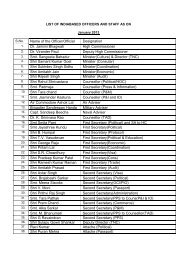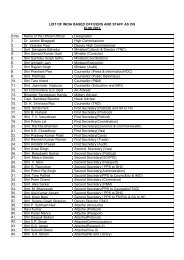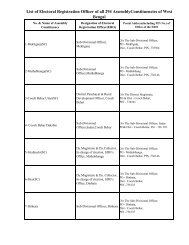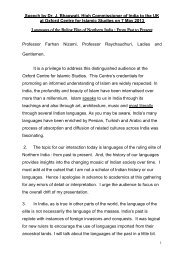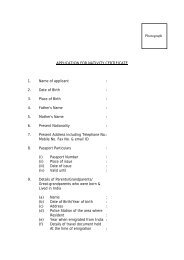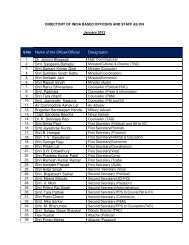India's - High Commission Of India
India's - High Commission Of India
India's - High Commission Of India
You also want an ePaper? Increase the reach of your titles
YUMPU automatically turns print PDFs into web optimized ePapers that Google loves.
1st issue of August 2013A Fortnightly publicAtion oF the high commission oF indiA, londonVol. 11 Issue: 15<strong>India</strong> launchesInsat-3DP3Green boon witheucalyptus P6History andharmonyP8People’s PresidentAn active politician for over four decades, President Pranab Mukherjeecompletes one year in office — a period marked by several proactive stepsMEA gets interactive withone-stop-shop mobile appNow, you can access <strong>India</strong>’sExternal Affairs Ministrywebsite, its passport services,get to know your Haj status, or evenpose a question on foreign policy to theMinister — thanks to a smartphoneapp MEA<strong>India</strong> — launched in NewDelhi on July 29.“It’s a one-stop-shop to provide youall you need to know,” said formerForeign Secretary Ranjan Mathai afterinaugurating the app at an event in NewDelhi. He retired on July 31.Through the app, the Ministry hadtried to “adapt and adopt” to the needsof communication today, Mathai said.The Ministry website, which last yeartook on a new look, is on course to get amillion visitors in the first year of itslaunch, he added.The Ministry’s common digitalIdentity “is falling in place”, with all the120 <strong>India</strong>n missions adopting a similartemplate. While 50 missions have adoptedthe new template and made the transition,the others are set to do so by2014, he said.President Pranab Mukherjee inaugurating thenew cricket ground at the President’s Estate inNew Delhi to mark his one year in office.His Facebook page has over35,000 likes, he is onYouTube, he has done awaywith excessive security tomingle with the crowd, stuffy honorificshave been replaced and the palatialRashtrapati Bhavan has been thrown opento visits by the public — just some of thethings that President Pranab Mukherjeehas done in his first year in office to liveup to being a ‘People’s President’.Mukherjee, 77, who became <strong>India</strong>’s13th President on July 25 last year afteran active political life of over 40 years,has kept up the momentum of being aPresident who thinks differently and yetmaintaining the decorum of the highoffice since taking over the country’stop job, largely seen as ceremonial.Right from his well-crafted speeches,which always have something to sayto the people, his decision to drop thehonorific of “His Excellency”, his decisionto confine most presidential functionswithin the Rashtrapati Bhavan toprevent inconveniencing the public —Mukherjee has always been in the publiceye.To mark the day, the President had abusy schedule with back-to-back functions— opening a public library forresidents of Rashtrapati Bhavan, dedicationof a cricket ground in the schoolwithin the President’s estate, unveilingof a bronze statue of Mahatma Gandhiand launch of digital initiatives linkedThrough the app, people can get help withpassport, visa, and even share their views on<strong>India</strong>’s foreign policy.The Ministry is also reaching outacross the country in different languagemedia. Besides providing informationin Hindi, the Ministry is now providinginformation in Malayalam, Bengali,Tamil and Urdu. Press releases inAssamese and Telugu are soon to begin,Mathai said.Through the app, people can get helpwith passport, visa, and if abroad getconsular assistance, or even share theirviews and join the larger conversationon <strong>India</strong>’s foreign policy.Users can also find out how toundertake the Kailash ManasarovarYatra and Haj Pilgrimage.to the President’s website.During the last one year as thePresident of the country of over onebillion people, Mukherjee had travelledto 23 states, which includes five statesof the North-East during which he visited36 educational institutions.Tours to Rashtrapati Bhavan are opento the public three days a week, thechange of guard ceremony everySaturday has been thrown open to thepublic, the library and its trove ofancient books, which were in anunkempt state earlier, have beenrestored and catalogued.Besides opening up to the public,Mukherjee has sought to create morefacilities for the large number ofRashtrapati Bhavan staff. The Presidenthas begun sports facilities for the childrenof staffers. The President has alsoroped in the <strong>India</strong>n National Trust ForArt and Cultural Heritage for conservationof the 320-acre Presidential Estate.Air <strong>India</strong>’s maiden Dreamlinerflight lands in BirminghamBirmingham Airport welcomedAir <strong>India</strong>’s first Dreamlinerflight connecting Birminghamwith Amritsar and New Delhi. The Air<strong>India</strong>’s Dreamliner AI 461, with nearly220 passengers on board, was warmlywelcomed at the airport on August 1.The new service now operates fourtimes weekly each Monday, Tuesday,Thursday and Saturday.The 256 seat B787-8 series aircrafthas a split cabin, consisting of 18 businessclass and 238 economy seats.Welcoming the inaugural flight, theAirport’s CEO, Paul Kehoe, said, “WeAir <strong>India</strong>’s inaugural Boeing 787 ‘Dreamliner’flight touches down at Birmingham airport.‘<strong>India</strong> to achieve80 percent literacyrate by 2015’THE GOV-ERNMENT ishopeful of achieving80 percent literacyrate by 2015,Human ResourceDevelopmentMinister Dr.HRD Minister Dr.M.M. PallamM.M. Pallam Raju.Raju said recently.“Our efforts are being upscaledand I see no difficulty in achieving80 percent literacy rate by 2015,”Minister Raju said on July 18.Inaugurating the InternationalConference on Achieving Literacyfor All in New Delhi, MinisterRaju said over 20 crore people havebecome literates since the lastCensus of 2001, out of which morethan half are females.He said his Ministry is restructuringthe adult education systemwith a paradigm shift to lifelongeducation.are delighted to welcome this newservice into Birmingham and to nowoffer regular scheduled services toDelhi and Amritsar on the fantasticDreamliner aircraft. Air <strong>India</strong> hasresponded to the enormous demandthat lies in our catchment and wethank all the support received from theCity, and indeed the region, to securethese direct flights.”The Chairman of Air <strong>India</strong>, RohitNandan, flew in on the inaugural serviceand was welcomed by a delegationof Midlands’ VIPs, including Sir AlbertBore, the Leader of Birmingham CityCouncil and Sri V.S. Ramalingam, theConsul General for <strong>India</strong> inBirmingham.Commenting on the special occasion,Sir Albert Bore, Leader of BirminghamCity Council, said: “Birmingham has aproud reputation as a diverse city, withresidents from the wider <strong>India</strong>n subcontinent.It makes a great deal of sensefor there to be a direct flight betweenDelhi and Birmingham, rather than justLondon.”
[ ] 1st issue of August 2013 2‘Take lead in solar power’The government’s Jawaharlal Nehru National Solar Mission’s success has the potentialto enhance <strong>India</strong>’s energy security, says Prime Minister Dr. Manmohan SinghPrime Minister Dr. Manmohan Singh addressing at the dedication ceremony of BHEL’s Power PlantPiping Unit & Unit-II <strong>High</strong> Pressure Boiler Plant to the Nation, in Thirumayam, Tamil Nadu.Take the lead in generatingsolar energy and developrequisite technology in<strong>India</strong>,” Prime MinisterDr. Manmohan Singh said onAugust 2.Referring to the Jawaharlal NehruNational Solar Mission for enhancing<strong>India</strong>’s energy security, the PrimeMinister asked Bharat Heavy ElectricalsLtd (BHEL) to take the difficult butworthy commercial decision in theinterest of the country.“The success of the solar mission hasthe potential to enhance the country’senergy security and contribute handsomelyto our efforts to combat climatechange,” Dr. Singh said, exuding hopethat the BHEL, bestowed with engineeringexpertise, manufacturingprowess and a commendable humanresource, would take the lead in solarenergy generation.“We need to develop ways and meansto reduce our carbon footprintthrough technological innovation,”Dr. Singh said after dedicating to thenation BHEL’s Power Plant PipingUnit (PPPU) at Tirumayam inPudukkottai district and Unit II of<strong>High</strong> Pressure Boiler Plant in theTiruchi Complex.Formally commissioning the PPPUthat commenced trial production earlylast year, the Prime Minister commendedBHEL for developing ultrasuper critical technology in line withthe country’s mission to invent cleancoal technologies.Dr. Singh said the government plansto add over 100,000 MW of generationcapacity, including renewable, in the12th Plan.In the 11th Plan period, the countryadded around 55,000 MW of generationcapacity, he added.<strong>India</strong> emerges as fourth-largestinvestor in United Kingdom<strong>India</strong> has emerged as the fourthlargest investor in the UK, creatingover 7,000 jobs, according tolatest foreign direct investment (FDI)figures released by the British governmentrecently.UK Trade and Investment (UKTI)published its ‘2012/13 InwardInvestment Annual Report’ revealingthat 89 <strong>India</strong>n FDI projects had helpedcreate as many as 7,255 jobs in Britain.It puts <strong>India</strong> in the top five inwardinvestor economies in the UK withthe US leading the charge with 396projects and 48,802 jobs, followedby Japan with 113 projects yielding7,442 jobs.Italy and France come in a joint thirdwith 93 projects each and 6,892 and16,001 jobs respectively. The figurescompare favourably to UKTI’sLONDON MAYOR Boris Johnsonhas described the post-Olympic surgein <strong>India</strong>n investments into Britain as“phenomenal”.Speaking at a press conference inLondon to mark a “year on” sinceLondon played host to the OlympicGames in July 2012, he also highlightedthe role played by Tata Motorsin a resurgence in Britain’s automotiveindustry.“The story of <strong>India</strong>n investment inBritain is absolutely phenomenal. TheUK is set to become the No. 2 car producerin the whole of the EuropeanUnion, largely thanks to <strong>India</strong>n investmentin the UK. That is a fantasticsynergy and we are very, very keen toencourage it,” he said.British Prime Minister David Cameron’s <strong>India</strong> visit in February2013 secured a range of deals and jobs.2011/12 report, when <strong>India</strong> hademerged as the fifth-largest investorwith 81 projects, creating 5,454 jobs.“UKTI has led an improvement inLondon Mayor Boris Johnson.According to recently released UKTrade and Investment (UKTI) figures,<strong>India</strong> is now the second-largestinvestor into London as a result of theinvestment fervour generated by thethe impact and senior-levelbusiness engagement inoverseas trade visits.February 2013’s PrimeMinisterial (DavidCameron), 109-strong businessdelegation to <strong>India</strong>secured a range of deals andjobs and further demonstratedour ability to deliverhigh-impact, innovative andprofessionally organised visits,”the UKTI report said.“Looking to the future,the increased funding in theAutumn Statement 2012will help deliver an ambitiouspackage of support designed toreinforce the UK as the location ofchoice for Europe-bound investors,”the report added.‘<strong>India</strong>n investments into Britain phenomenal’London 2012 Games. Overall in theUK, <strong>India</strong> beat Chinese foreign directinvestment (FDI) figures to emerge asthe fourth-largest investor with 89<strong>India</strong>n FDI projects which helped createas many as 7,255 jobs in Britain.Asked if his visit to <strong>India</strong> inNovember 2012, soon after theOlympics, was responsible for this<strong>India</strong>n FDI boost, Mayor Johnsonsaid, “I had a good trip to <strong>India</strong> butthat the rise in investments was insome way an after-shock effect of thatparticular trip, I wouldn’t say.”“But we are very keen to build upour intensified links between Londonand <strong>India</strong> and I will certainly be planninganother visit in the next 18months,” he added.The best is yetto come: PMPrime Minister Dr. Manmohan Singhunveiling the plaque to lay the foundationstoneof the new NCAER Centre in New Delhi.PRIME MINISTER Dr.Manmohan Singh laid the foundationstone of the National Councilfor Applied Economic Research’s(NCAER) new centre in NewDelhi on July 27.Urging the institution to maintainits high standards of economicresearch, the Prime Ministersaid, “The best is yet to come.”“I sincerely hope that this institutewill stay faithful to what itsfounding fathers stood for” Dr.Singh added.Dr. Rajendra Prasad laid downthe foundation stone of NCAERbuilding in 1959 and PanditJawaharlal Nehru inaugurated itin 1961.Dr. Singh was walked throughthe architectural plans for the NewCentre by a specialised teambefore his address and interactedwith eminent economists of thecountry at NCAER after theceremony.The NCAER is an independentnon-profit economic researchinstitution that assists the government,civil society and private sectorto make policy choices.
[ ] 1st issue of August 2013 3<strong>India</strong> launches weather satellite Insat-3DThe satellite will improve weather forecasting system, including predictions about the monsoon<strong>India</strong>’s advanced satellite Insat-3D,which was launched on July 26onboard Ariane-5 rocket fromKourou in French Guiana off thePacific coast, will improve weather andmonsoon forecasting system.“After a perfect lift-off at 01:24 a.m.from the European Arianespace spaceportat Kourou, the two-tonneadvanced weather satellite was placedin the geosynchronous transfer orbit(GTO) 32 minutes later, about 36,000km above from earth,” the <strong>India</strong>n SpaceResearch Organisation (ISRO) said ina statement.The sophisticated spacecraft is orbitingat perigee (closest to the earth) of249.9 km and apogee (farthest from theearth) of 35,880 km in the orbit.“The satellite’s solar panel was automaticallydeployed soon after it was separatedfrom the rocket’s upper cryogenicstage and our master control facility atHassan took over its control for furtherInsat-3D was launched onboard Ariane-5 rocket from Kourou in French Guiana off the Pacific coast.manoeuvres,” the ISRO statement said.Hassan is about 200 km from Bangalore.Preliminary checks of the subsystemsshowed the health of the spacecraft wassatisfactory.“The MCT will perform the orbitraisingmanoeuvres over the next fewdays using the satellite’s propulsion systemto place it in the intended geostationaryorbit,” the statement pointed out.The satellite will improve weatherforecasting system, including predictionsabout the monsoon.“This is a big step and will certainlyimprove our forecasting system,”Shailesh Nayak, Secretary, UnionMinistry of Earth Sciences, toldreporters in New Delhi.“Insat will send us data on weatherevery half-an-hour and these will beput in our computing models forpreparing weather forecast,” he said.Nayak, however, denied commentingon the accuracy. “The accuracy part,we will only come to know after usingit for 6-8 months.”The four instruments onboard thespacecraft are Imager, Sounder, DataRelay Transponder and Satellite AidedSearch & Rescue. The six channel imagercan take weather pictures of the Earthand has improved features compared tothe instrument in (Kalpana-1) andInsat-3A, the two <strong>India</strong>n geostationarysatellites, which have been providingweather services over the past decade.“The 19-channel sounder payloadadds a new dimension to monitorweather through its atmospheric soundingsystem, and provides vertical profilesof temperature, humidity and integratedozone,” the statement noted.Good show by <strong>India</strong>ns atWorld Police and Fire Games<strong>India</strong>n Police sportspersons producedan excellent performance atthe XV World Police and FireGames 2013, at Belfast, NorthernIreland, pocketing 11 gold, six silver andfour bronze medals so far. The 39-member <strong>India</strong>n team is taking part in anumber of disciplines — athletics,archery, boxing, judo, swimming andwrestling — in the August 1 to 10 event.The first medal was pocketed by SINandar Anand Divase of BSF onAugust 3 after he finished on top in theMen’s 400m freestyle swimming byclocking 4:12:21 minutes. <strong>India</strong>n teamcomprising Divase, Rohit Kumar ofCRPF, Rajvir Singh of Punjab Policeand Tulse Chetanya of Andhra PradeshPolice then went on to win the 4x50mfreestyle relay in 1:44:26 minutes.In athletics, <strong>India</strong> ended up with twomedals on the first day. Long distancerunner Anuradha Singh won a gold in5,000m for women, while Tajinder ofPunjab Police stood second inHammer Throw event for men.The second day saw the <strong>India</strong>nsadding as many as eight gold, four silverand three bronze to their kitty.The games are organised by theWorld Police and Fire GamesFederation since 1989.Domestic tourism up by20 percent, Andhra on topDomestic tourism grew byabout 20 percent in 2012while foreign tourist arrivalssaw a rise of six percent, the Ministry ofTourism said as it released the statisticsfor 2012.“The number of domestic touristvisits to <strong>India</strong>n states and union territoriesregistered an increase of 19.87percent in 2012 as compared to anincrease of 15.6 percent in 2011,” saida statement issued by the Ministry.Tirumala Venkateswara Temple.“In 2012, the number of domestictourists was 1,036 million as comparedto 865 million in 2011 and 748 millionin 2010,” added the statement.Andhra Pradesh was the mostpreferred destination among domestictourists with 206.8 million peoplevisiting the southern state followed byTamil Nadu, which got 184.1 millionvisitors and Uttar Pradesh at 168.4million.Tamil Nadu moved from the thirdto the second slot in 2012 while UttarPradesh dropped from first to third.“The number of foreign tourist visitsregistered a growth of 6.33 percentduring the year 2012 over 2011 whilethe number of arrivals was 20.7 millionin 2012 as compared to 19.5 millionin 2011 and 17.9 million in 2010,”said the statement.<strong>India</strong> partners development across the worldIt is one of the largest such knowledgetransfer and development assistanceprogrammes in the world thathas helped <strong>India</strong>, a developing countryitself, share its expertise with others. Inthe process it has helped build a reservoirof goodwill for <strong>India</strong> across Africa,Latin America and Southeast Asia.Through its <strong>India</strong>n Technical andEconomic Cooperation (ITEC) programme,launched in 1964 as a bilateralprogramme of assistance, <strong>India</strong> hasbeen “sharing its knowledge and skillsacquired in its own developmentprocess with other developing countriesgoing through the same processof development”, said Kumar Tuhin,<strong>India</strong>n engineers at work at the AfghanParliament construction site in Kabul.Joint Secretary, DevelopmentPartnership Administration-II, in theExternal Affairs Ministry.<strong>India</strong> is helping 161 countries, withmany in Africa, Latin America andSoutheast Asia, in a big way in capacity-buildingunder ITEC.Under capacity-building, the ITECpartner countries send officials to <strong>India</strong>for training in fields like IT, entrepreneurshipand English language, or<strong>India</strong> sends its experts to advise on howto set up similar institutions.<strong>India</strong> also provides to developingcountries Lines of Credit, or loans givenat concessional terms to financedevelopment projects.The Cuu Long Delta Rice ResearchInstitute, set up in Vietnam, is a primeexample of the effect of the ITECprogramme.Another aspect of ITEC is the fullysupported and funded project grant.This aspect of ITEC has grown substantiallyin neighbouring South AsianAssociation for Regional Cooperation(SAARC) as well as those in SoutheastAsia and the extended neighbourhoodof Africa.Among examples of the project grantare: In Afghanistan, the Parliamentbuilding being constructed in capitalKabul as well as the Salma damand power transmission lines; in SriLanka, houses being built for theinternally displaced and dredging workof Kankesanthurai harbour; and inNepal, an emergency and traumacentre coming up in Kathmandubesides integrated check posts andTerai roads.
[ ] 1st issue of August 2013 6They look like normal eucalyptustrees up to 65 feet tallwith a trunk girth of about 19cm and towering over theirpeers in an evaluation trial on thefoothills of Himalayas in Dehradun.They are hybrids, progenies of two highgrowthspecies of eucalyptus parent trees.The progenies — just about sixyears-old— have shown a growth patternwhich is substantially higher overa commercially available clone varietyof their age and with approximateheight of 25 feet and girth of 6 cm.Welcome to the world of tree breedingat the Forest Research Institute(FRI), in the Himalayan foothills,where <strong>India</strong>n scientists are working todevelop fast-growing, taller and thickereucalyptus trees so that their plantationscan satiate the paper industry’sdemand and, in effect, help reduce theload on other species of the naturalforests for the purpose.The fast-growing progenies are thecentre of attraction at New Forest in theFRI campus and hold promise of developingfuture eucalyptus varieties to feedpulp or biomass to the paper industryand other wood-based industries.“In eucalyptus tree breeding, scientistsare developing hybrids with controlledhybridisation among desired genotypesof different eucalyptus species,” said FRIDirector P.P. Bhojvaid.A hybrid that grows taller and fasterGreener, tallerand better<strong>India</strong>n scientists are working todevelop fast-growing hybrideucalyptus trees in orderto save natural forestsGreen Boon: Scientists are developing hybrids with controlled hybridisation among desired genotypes of different eucalyptus species.with greater volume is cloned and multiplied.In this way, the plants producedwill have identical features and growthpatterns and could be distributed amongfarmers and growers who undertake captiveplantation for the paper industry.Ashok Kumar, head of the FRI’sDivision of Genetics and TreePropagation, said: “Cloning continuesparallel with tree breeding, adoptingconventional and tissue culture techniques(in a sophisticated lab).”He said the FRI recently released a cloneof eucalyptus propagated through tissueculture — FRI-EH-001 — after establishingits higher growth and biomass productionin different locations such asHaldwani in Uttarakhand, Hoshiarpur inPunjab and Hissar in Haryana, whichreport different geographical conditionslike land, rainfall and temperature.Normally, a good quality eucalyptustree is considered to be one which growstall and its trunk fast becomes thick.The FRI, an institute of the <strong>India</strong>nCouncil of Forestry Research andEducation under the Ministry ofEnvironment and Forests, has, over theyears improved the quality of eucalyptusto such an extent that a biomass of up to40 cubic metres per hectare per year couldbe possible in experimental conditions.A related research paper titled “Sustainedhybrid vigour in F1 hybrids of E. torellianax E. citriodora” was published during 2010in World Applied Sciences Journal.n News from The Nehru CentreMusings of the Infinite:a photo-exhibitionTHE NEHRU CENTRE organiseda photoexhibitiontitled‘Musingsof theInfinite’ byDr. Ashish Dubey on July 16. There isa threat to wetlands in <strong>India</strong> and thephotographs intended to draw attentiontowards the conservation ofthe same.Dance recital by KrishmaGajjar & Alisha MannA CONTEMPORARY and semiclassicaldancerecital byKrishmaGajjar andAlishaMann leftthe audiences spellbound on July 16.A tribute to Sitar LegendPandit Ravi ShankarMARKING THE auspicious occasionof Guru Purnima, the NehruCentre,in associationwithSujataBanerjee Dance Company, organiseda two-day dance and music festival asa tribute to Sitar legend Pandit RaviShankar on July 17-18. The festivalsaw performances by dancers fromEncee Academy, OMKAAR and a sitarsolo by Gaurav Mazumdar.Music album launch ofSajdaa by Prabhjyot KaurSAJDAA, THE first music album ofPrabjyot Kaur, was launched at the NehruCentre onJuly 22.The musicfor Sajdaahas beencomposedby legendary tabla maestro Ustad Tari Khan.The album contains a variety of songs,including Punjabi, Arabic, Folk andWestern-style numbers.Sum of Impressions: Anexhibition by Tushar SabaleAN EXHIBITION of paintings byeminent <strong>India</strong>n artist Tushar Sabale washeld at TNC on July 23. The exhibition,titled ‘Sum of Impressions’, reflectedSabale’s takeon varioussubject mattersspanningthe entirespectrumfrom still lifeand figures to personal collections andcommissions of portraits.Satyajit Ray Foundation’sShort Film Competition 2013THE NEHRU CENTRE hosted theSatyajit Ray Foundation’s Short FilmCompetition 2013 as part of the 4thLondon <strong>India</strong>n Film Festival on July23. Six short movies were screened atthe event — Calcutta Taxi directed byVikram Dasgupta; I am micro byShumona Goel and Shai Heredia; Fauxdepartment’ by Shekhar Bassi; SikhFormaggio by Katie Wise, Devyn Bisonand Dan Duran; On migration by AsheqAkhtar and Kaun Kamleshwar? byAnurag Goswami.Book Launch — TheEmpire of the SikhsTHE ANGLO-SIKH HeritageTrail/Peter Owen Publishers and TNCorganised the book launch of TheEmpire of the Sikhs - A biography of theMaharaja Ranjit Singh on July 25. Thebook, first published in 2008, was coauthoredby Patwant Singh and Jyoti M.Rai, and became a landmark work.Painting exhibition:Elements of NatureAN EXHI-BITION ofpaintings —‘Elements ofNature’ —by LondonbasedartistMeeta Garg was organised at TNC onJuly 29. The exhibition covered threeelements of nature — earth, water andspace, in which the moon was representedin all its dreamy, unearthlybeauty.Classical music eveningby Carnatica brothersA LECTURE-cum-demonstrationconcert by Shashikiran and SriGanesh, internationally renowned astheCarnaticaBrothers,was heldatTNCon July 30.The duoblendedinnovation with tradition in theirvocal renditions of South <strong>India</strong>n classicalmusic.Musical tribute toMohd. RafiCOMMEMORATING THE 33rddeath anniversary of legendaryBollywood singer Mohd. Rafi, TNCorganiseda musicalevening ofhis songson July 31.Londonbasedsinger Muhammed Fahad and his teamrendered Rafi Sahib’s evergreenclassics to a packed auditorium ofRafi fans.
aaaaLok/khurk laxzke dhØkafrdkjh /kkjk esa R;kx vkSjHkkjrh;cfynku dk tTck iSnk djus vkSjns'k es a vktknh ds fy, tkuU;ksNkoj djus dk lkgl Hkjus okys çFke lsukuh[kqnhjke cksl ekus tkrs gS aA mudh 'kkgnr usfganqLrkfu;ks a es a vktknh dh tks yyd iSnk dhmlls Lok/khurk vkanksyu dks u;k cy feykA[kqnhjke cksl ek= 19 lky dh mez es a ns'k dsfy, Qkalh ds Qans ij >wy x, FksA caxky esfenukiqj ftys ds gchciqj xkao es a =SyksD; ukFkcksl ds ;gka 3 fnlacj] 1889 bZ- dks tUe ysusokys [kqnhjke cksl tc cgqr NksVs Fks rHkh mudsekrk&firk dk fu/ku gks x;k FkkA mudh cM+hcgu us mudk ykyu&ikyu fd;k FkkAcaxky foHkktu ¼1905 bZ-½ ds ckn [kqnhjkecksl Lora=rk vkanksyu esa dwn iM+s FksA lR;sucksl ds usr`Ro esa [kqnhjke cksl us viukØkafrdkjh thou 'kq: fd;k FkkA[kqnhjke cksl jktuhfrd xfrfof/k;ksa esa Ldwyds fnuksa ls gh Hkkx ysus yxs FksA ostyls&tqywlksa esa 'kkfey gksrs Fks rFkk vaxzsthlkezkT;okn ds f[kykQ ukjs yxkrs FksA mUgksausukSoha d{kk ds ckn gh icw> okys FksAbudh [kq'kh dk dksbZ fBdkuk ugha FkkA ns'k Hkäksdks rax djus okyks a dks ekj Mkyus dk dke mUgslkS aik x;k FkkA ,d fnu os nksuks a eqtQjiqjigq ap x,A ogha ,d /keZ'kkyk es a os vkB fnu jgsAbl nkSjku mUgks aus fdaXlQksMZ dh fnup;kZ rFkkxfrfof/k;ks a ij iwjh utj j[khA muds caxys dsxaxk unh dks fgUnw leqnk; esa i`Foh dhlokZf/kd ifo= unh ekuk tkrk gSA eq[; /kkfeZdvk;kstu unh ds fdukjs fLFkr 'kgjks a es a fd, tkrsgS a tSls okjk.klh] gfj}kj vkSj bykgkcknA vHkhrd ;g ekU;rk jgh gS fd xaxk ty es a dhVk.kqugha iSnk gksrsA xaxk unh ckaXykns'k ds lq anj ou}hi es a xaxk MsYVk ij vkdj O;kid gks tkrh gSvkSj blds ckn caxky dh [kkM+h es a feydjbldh ;k=k iwjh gksrh gSAnSfud ç;ksx ds “kCnCure : mipkj@fpfdRlkAdult : ifjiDo@o;LdBackground : Ik`’BHkwfe@fiNokM+kDozen : ntZu@ckjgLightning: fctyh@nkfeuhm)j.kn vuUr”kkL=a cgqyk”p fo|k%] vYi”p dkyks[ ] 1st issue of August 2013 7[kqnhjke cksl us txkbZ Fkh cfynku dh vy[kikl gh Dyc FkkA vaxz sth vf/kdkjh vkSj mudsifjokj ds yksx 'kke dks ogka tkrs FksA30 vçSy] 1908 dh 'kke fdaXlQksMZ vkSjmldh iRuh Dyc esa igqapsA jkf= ds lkdj ml ij ce Qsad fn;k]ftlls mlesa lokj eka&csVh dh ekSr gks xbZAØkafrdkjh bl fo'okl ls Hkkx fudys fdfdaXlQksMZ dks ekjus esa os lQy gks x, gSaA[kqnhjke cksl vkSj çQqYy pan 25 ehy rdHkkxus ds ckn ,d jsyos LVs'ku ij igqapsA[kqnhjke cksl ij iqfyl dks lansg gks x;k vkSjiwlk jksM jsyos LVs'ku ¼vc ;g LVs'ku [kqnhjkecksl ds uke ij gS½ ij mUgsa ?ksj fy;kA viusdks f?kjk ns[k çQqYy pan us [kqn dks xksyhekjdj 'kgknr ns nh ij [kqnhjke idM+s x,Amuds eu esa rfud Hkh Hk; ugha FkkA[kqnhjke cksl dks tsy esa Mky fn;k x;k vkSjmu ij gR;k dk eqdnek pykA vius c;ku esaLohdkj fd;k fd mUgksaus rks fdaXlQksMZ dksekjus dk ç;kl fd;k FkkA ysfdu] bl ckr ijcgqr vQlksl gS fd funksZ"k dSusMh rFkk mudhcsVh xyrh ls ekjs x,Aeqdnek dsoy ikap fnu pykA 8 twu] 1908dks mUgsa vnkyr esa is'k fd;k x;k vkSj 13 twudks mUgsa çk.k naM dh ltk lqukbZ xbZA 11vxLr] 1908 dks bl ohj Økafrdkjh dks Qkalhij p
[ ] 1st issue of August 2013 8Historyand harmonyVisiting Andhra Pradesh is a delight with the stunning Eastern Ghats nearVisakhapatnam, the holy maze at Tirumala, the temple architecture atWarangal and the cultural mix at Vijayawada(Clockwise from above) A hilltop view of the Bheemunipatnam town; the 1000-Pillared Temple on the slopes of Hanamkonda in Warangal; a panoramicview of the Buddha statue and other monuments at Nagarjunakonda; and the Charminar in Hyderabad.Andhra Pradesh offers a varietyof surreal experiences —subtle charms, quiet traditions,spiritual scholarshipand religious harmony, evident in theform of the large number of temples,mosques and churches that dot the state.Andhra Pradesh has a rich historicalpast. The state was an integral part ofEmperor Ashoka’s vast Kingdom andnot surprisingly an important Buddhistcentre as well. Today ruins of stupas andmonasteries defy impermanence aroundthe state, especially at Amaravathi andNagarjunakonda. It was then ruled byseveral dynasties and prominent amongthese were the Pallavas, the Chalukyas,the Kakatiyas and the Mughals. All thesedynasties have played a significant rolein contributing to the rich cultural heritageof the state and their presence isstill felt in the monuments that still surviveafter the passage of so many years.Andhra Pradesh’s rich Islamic historyannounces itself in Hyderabad’s huge,lavish mosques, its opulent palaces andthe stately Qutb Shahi tombs — butalso, more softly, in a tiny spiral staircasein the Charminar and in the sounds ofUrdu floating through the air.Travelling within Andhra is a delightwith the stunning Eastern Ghats nearVisakhapatnam, the holy maze atTirumala, the beaches at Visakhapatnam,the temple architecture at Warangal andthe cultural mix at Vijayawada.The state is set to become the newbeach destination of <strong>India</strong> if the TourismMinister is able to implement his plans.With Telugu superstar-turned-politicianChiranjeevi, who is from AndhraPradesh, as the Minister of State forTourism (Independent Charge), thestate is aiming to carve a niche for itselfin beach tourism by pumping moneyinto creating coastal corridors along theBay of Bengal as well as developingeight of its beach properties.Does Goa serve as an inspiration forAndhra Pradesh’s next big tourismthrust? Not really, says Chandana Khan,Andhra Pradesh’s Special Secretary(Tourism and Archaeology).“We think Goa has a very different setof offerings. Andhra Pradesh has a veryunique image and has something foreverybody. This combination of uniquechoices makes <strong>India</strong> a special mix for thevacation planners,” Khan said.“We believe the natural beauty of ourbeaches will attract consumers whowant to take a break from the regularhustle-bustle of city life,” Khan said.With a 970-km coastline and relativelyvirgin stretches of beach, the AndhraPradesh government now expects aninvestment of about $222 million,through public-private partnership projectsthat it believes will shoot high thestock of its coastal tourism.“A separate coastal corridor is beingdeveloped to link Visakhapatnam withBheemunipatnam (in northeasternAndhra Pradesh),” Khan said, addingthat nine beaches including Baruva,Perupalem and Kotta Kudur, would getproperties developed by the AndhraPradesh Tourism DevelopmentCorporation (APTDC).Must VisitCHOWMAHALLA PALACE,Hyderabad & SecunderabadThe Nizam family has sponsored arestoration of this dazzling palace –or, technically, four (char) palaces(mahalla). Begun in 1750, it wasexpanded over the next 100 years,absorbing Persian, Indo-Saracenic,Rajasthani and European styles.MUSEUM OF HABITAT,Araku ValleyAndhra’s best train ride is throughthe magnificent Eastern Ghats to theAraku Valley, 120km north of Vizag.The area is home to isolated tribalcommunities, and the tiny Museumof Habitat has fascinating exhibits ofindigenous life.1000-PILLARED TEMPLE,WarangalBuilt in 1163, the 1000-PillaredTemple on the slopes of HanamkondaHill is a fine example of Chalukyanarchitecture in a peaceful, leafy setting.BIRLA MANDIR, Hyderabad &SecunderabadThe Birla temple, constructed ofwhite Rajasthani marble in 1976,graces Kalabahad (Black Mountain),one of two rocky hills overlookingthe Hussain Sagar.UNDAVALLI CAVE TEMPLES,VijayawadaFour kilometres south-west ofVijayawada, the stunning Undavallicave temples cut a fine silhouetteagainst the palm trees and rice paddies.Shrines are dedicated to theTrimurti – Brahma, Vishnu and Shiva.NAGARJUNAKONDAMUSEUM, NagarjunakondaThe thoughtfully laid-outNagarjunakonda Museum has StoneAge tools on exhibit, but more excitingare its Buddha statues and carvedstone slabs that once adorned stupas.Disclaimer: <strong>India</strong> Digest gathers its contents from diverse sources and the views expressed in interviews and articles published do not necessarily representthe views of the <strong>High</strong> <strong>Commission</strong> or the Government of <strong>India</strong>.Printed and published by the Press & Information Wing, <strong>High</strong> <strong>Commission</strong> of <strong>India</strong>, <strong>India</strong> House, Aldwych, London WC2B 4NA. Tel: 0207 632 3005 . Fax: 0207 632 3204.Email: couns.pd@hcilondon.in Website: www.hcilondon.in



